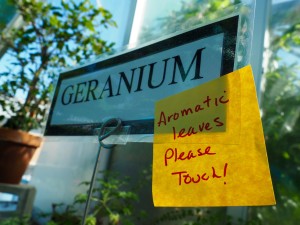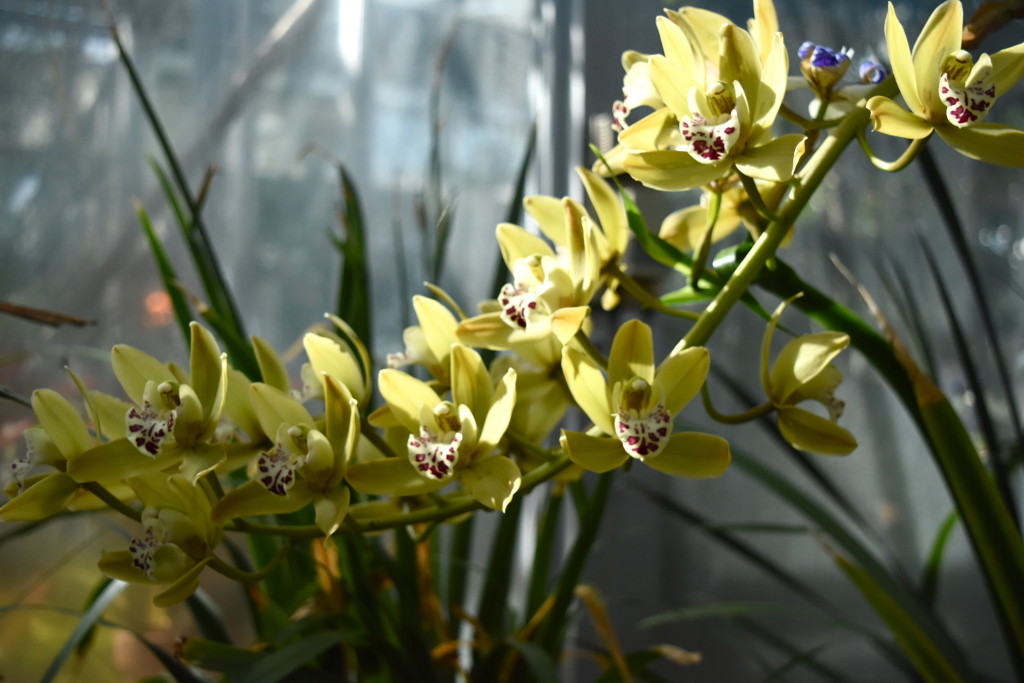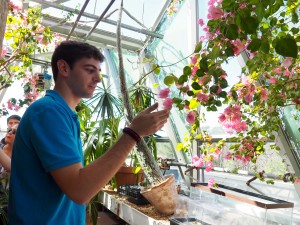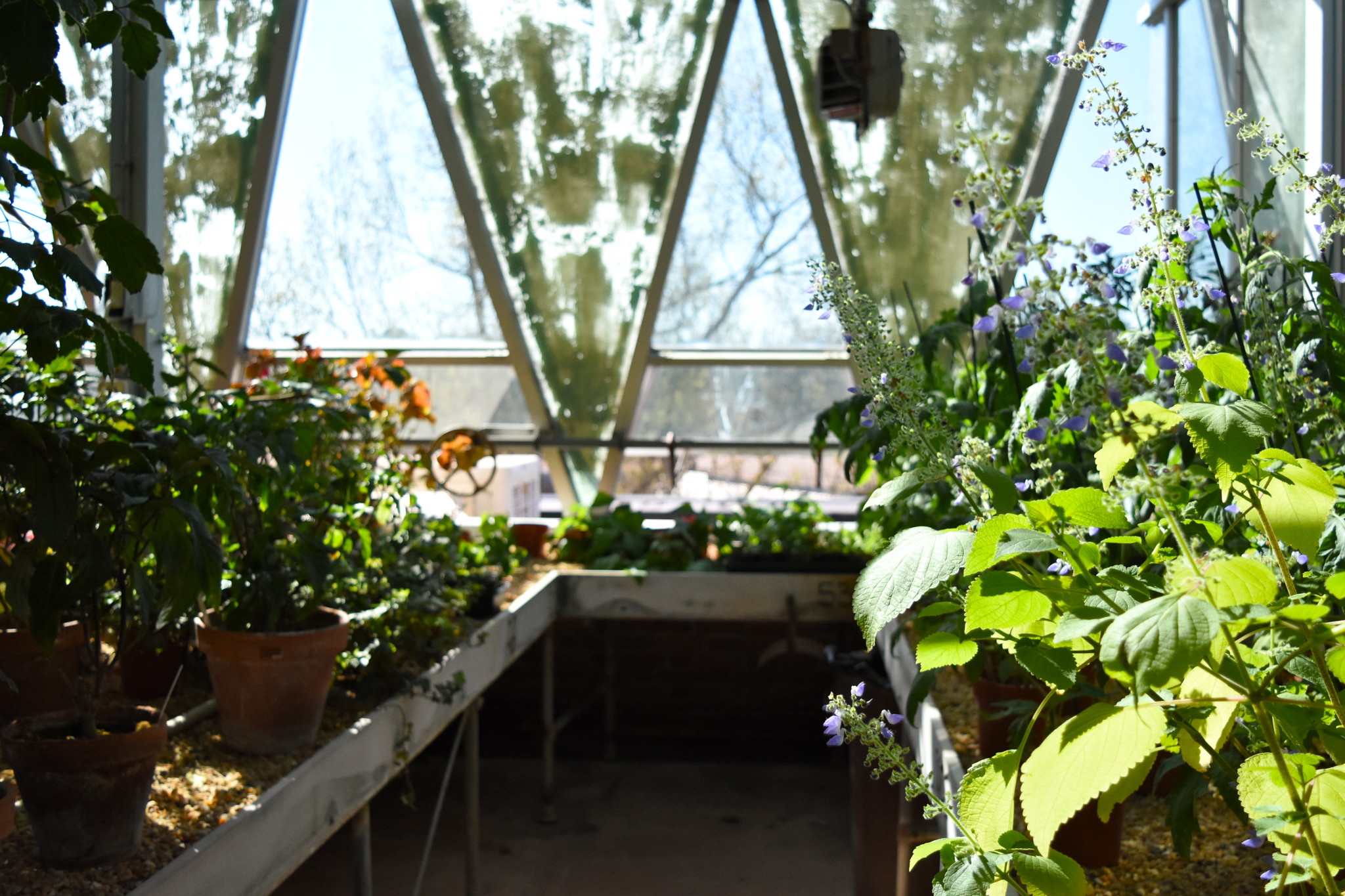The gloomy Williamsburg sky brightened for a moment as students gathered on the roof of Millington Hall for the greenhouse goodbye party March 18.
The greenhouse has been a hidden gem tucked away on the fourth floor of Millington Hall since its construction in 1969. Next semester, however, Millington is being torn down, and the greenhouse will be relocated to the roof of the new Integrated Science Center.
The old greenhouse’s farewell party kicked off at 2:30 p.m. Friday. Attendees took self-guided tours of the greenhouse while listening to live music and enjoying refreshments. The musical line-up included Greg Taylor, the Appalachian Music Ensemble and a band fittingly named Talk to Plants. Edible crickets were among the refreshments provided for those feeling particularly adventurous that day.
The greenhouse itself is like a tiny maze of botanical wonders that satisfy the senses. The hundreds of green plants provide a visually appealing backdrop for photos. Visitors can smell the soothing scents of the ginger plants or the lemon eucalyptus tree. Pair these features with nice weather and, according to student volunteer Rachael Carlberg ’17, the greenhouse becomes the perfect place to go to escape.
“I think it’s such like a really relaxing place. It’s probably my favorite place on campus,” Carlberg said. “I just think it’s really beautiful up there. I just think it’s really peaceful and nice. It’s a really nice place to get away from the stress of school work.”

Visitors can even interact with a plant called mimosa pudica, which is also known as the sensitive plant. It’s called the sensitive plant because its leaves shyly fold into themselves when they are touched.
The plants are organized in a few different ways. Some, like the cacti and succulents, are grouped by type. Other plants are paired together to ensure that they receive the proper amount of sunlight and shade.
The greenhouse also includes a water component that is home to a few turtles from Lake Matoaka. The new greenhouse will not include this water component, however, so the turtles will either be released back into Lake Matoaka or taken to someone’s man-made pond.
Relocating the greenhouse from Millington will mean leaving behind a long history. When it was first built in 1969, faculty were excited about the new location. Professors had trouble growing plants that needed a lot of sunlight in the previous ground-floor greenhouse, so the rooftop location was ideal. An article in the 1972 edition of William and Mary News even called it the College’s “penthouse.” It became a popular location for the William and Mary Faculty Club to hold brunches and cocktail parties in the late 1970s.
According to volunteer Janhavi Giribhattanavar ’17, during homecoming weekend, alumni sometimes come back to the greenhouse to see if some of the plants they grew in their botany classes are still there.
In its early years, maintenance of the greenhouse relied heavily on the work of outside volunteers. Over the decades, the greenhouse has attracted more student workers and volunteers. Giribhattanavar saw a job posting at the greenhouse while on a tour last spring semester. She watered the plants at the greenhouse everyday over the summer while she was on campus doing research. She now spends about five to six hours a week at the greenhouse.
“I love seeing the new growth on the plants, like when there are new leaves and new flowers,” Giribhattanavar said.
Student involvement at the greenhouse is not limited to working and volunteering. The William and Mary Botany Club uses the greenhouse to hold meetings and conduct club projects.
Students and faculty also use the greenhouse for research. Joshua Puzey, an assistant professor who specializes in plant development, biomechanics and genomics, described some of the current research projects.

I love seeing the new growth on the plants, like when there are new leaves and new flowers.
“One of my students is looking at the biomechanics of morning glory movement,” Puzey said. “Morning glories are flowers that open in the morning time and then they close in the evening. The student is exploring the biomechanics of how that motion takes place. Another student is using the greenhouse to look at variations in petal spots.”
In the past, the poor climate control in the Millington greenhouse has made research difficult. The new greenhouse will include better heating, cooling and light intensity control systems.
“The biggest conceptual transition from the old greenhouse to the new greenhouse is the new greenhouse is going to be much more research-focused,” Puzey said.
Students will be growing milkweed plants at the new greenhouse this summer to study the interaction between milkweed plants and monarch butterflies.
Though the new greenhouse will create a more research friendly environment, both Carlberg and Giribhattanavar said they will miss the old charm of the Millington greenhouse. Older plants have begun to grow into benches and onto the brick walls. The roots of some plants have even shattered and engulfed the outsides of their pots. Giribhattanavar says she regrets that they will not be able to take these plants with them to the new greenhouse.

Still, there are other benefits to the new location. Carlberg says she often felt students didn’t visit the Millington greenhouse because they didn’t know it existed. She is hopeful that more people will come visit the new one once it opens.
“I’m really excited that it really has a little bit more of a central place on campus,” Carlberg said. “It’s a lot more visible on top of the ISC. People are seeing it being built. I hope that it becomes more of a popular spot and that new students will come and see it.”
Those who have not yet had a chance to see the Millington greenhouse can visit until the end of the semester. The greenhouse is open Tuesdays from 12:30 p.m. to 3:00 p.m; Wednesdays from 9:30 a.m. to 1:30 p.m. and Thursdays from 9:00 a.m. to 3:00 p.m.

